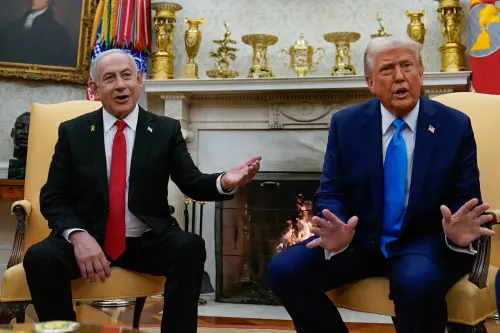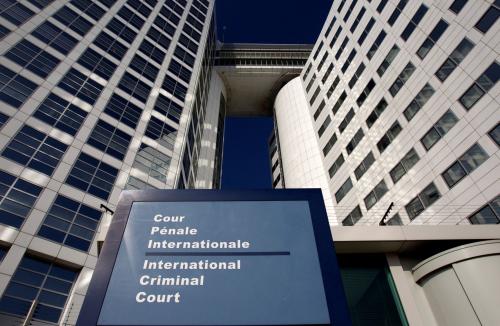Also read recent analysis by Kevin Huggard and Natan Sachs about Israel’s current political situation.
Israelis voted in two Knesset elections in 2019, and a third will now follow in early 2020. Meanwhile, Attorney General Avichai Mandelblit announced the indictment of Prime Minister Benjamin Netanyahu, escalating the legal drama surrounding the prime minister. The task of forming a new coalition may be just as difficult after the third election as it was after the first two, but after a year of political paralysis, the stakes continue to rise. Below, we lay out the key dates for understanding where Israel is headed in the new year and look back at the milestones of a convoluted year in Israeli politics.
A Tumultuous Year in Israeli Politics
LOOKING AHEAD: ON TO ELECTIONS, AGAIN
Amid political deadlock, Israel heads into 2020 looking toward its third elections in 11 months
- December 26
- Likud party primaries: Netanyahu vs. Sa’ar.
Gideon Sa’ar, former minister of education and the interior, will challenge Netanyahu in a primary to determine the leadership of the Likud Party heading into the March elections.
- January 15
- Last day to submit lists.
Parties must complete their internal processes for forming their lists of candidates, and any inter-party alliances must be finalized. Lists are submitted to the Central Elections Committee.
- February 1
- Lists finalized by Central Elections Committee.
After any legal or administrative challenges are resolved, the Central Elections Committee will finalize the electoral lists.
- March 2
- Israelis vote for a third time.
Israelis will vote for the 23rd Knesset, the third Knesset to be elected within a span of 11 months. Each voter casts a vote for a single list of candidates representing a party or parties. Votes are counted in a single national district, and the 120 seats of the Knesset are then allotted proportionally to the votes counted. (See here for a more detailed explanation of the electoral system). Exit polls will be published 10pm Israel time (3pm EST/8pm GMT).
- March 7-10
- Election results submitted; government formation process begins.
The official elections results will be submitted to President Reuven Rivlin, who will then task a Member of Knesset with forming a government.
HOW DID WE GET HERE?
2019: Two elections, an indictment, but no new government
February 28
Mandelblit announces intention to indict Netanyahu.
With just 38 days to go before national elections, Israel’s attorney general announces his intention to indict the prime minister in three criminal cases, pending a pre-trial hearing.
April 9
Israelis vote; Netanyahu the apparent winner.
Of the 120 Knesset seats, 65 were won by right-wing parties expected to support Netanyahu. It seemed a clear victory for the prime minister.
April 29
Netanyahu fails to form government; Knesset dissolves itself.
Netanyahu, opposed by Avigdor Lieberman, leader of Yisrael Beiteinu and his one-time close aide, failed to form a governing majority. The prime minister then led the Knesset to dissolve itself, preventing another MK from being given the chance to form a coalition and triggering new elections.
September 17
Israelis go to the polls, again.
Israelis voted in the second Knesset elections of the year after the 21st Knesset dissolved itself in May. Early returns showed no clear winner, but indicated that Netanyahu would face a difficult path in forming a government.
September 25
Netanyahu gets the first shot.
President Reuvin Rivlin tasked Netanyahu with forming a government after the sitting prime minister received 55 recommendations for the post, one more than his chief rival, Benny Gantz.
October 2
Netanyahu’s pre-trial hearing begins.
At a closed-door hearing, Netanyahu’s lawyers argued to the Justice Ministry that charges should be dropped in his bribery, fraud, and breach of trust cases.
October 21
Netanyahu returns his mandate.
Netanyahu, unable to form a government during his allotted 28 days, returned the mandate to Rivlin.
October 23
Gantz gets his chance.
Rivlin tasked Blue and White Party Leader Benny Gantz with a mandate for forming a government.
November 20
Gantz’s deadline passes; open period begins.
Gantz’s 28 days to form a government end with no coalition. A 21-day period followed in which any member of Knesset (MK) could attempt to garner support of a majority of MKs to receive a new mandate.
November 21
Netanyahu indicted.
Attorney General Avichai Mandelblit announced his decision to indict Prime Minister Benjamin Netanyahu in three corruption cases. At the time, we wrote that “Mandelblit’s decision was not in and of itself a surprise, but that this indictment will include a charge of bribery, the most serious charge Netanyahu faced, represents the worst possible legal and political outcome for the prime minister.”
December 11
Government formation period ends, forcing a third election.
For 21 days, anyone — including Gantz or Netanyahu — could have garnered the support of 61 MKs to receive a mandate to form a coalition. As no one succeeded in doing so, Israelis will go the polls for the third time in 11 months.
The Brookings Institution is committed to quality, independence, and impact.
We are supported by a diverse array of funders. In line with our values and policies, each Brookings publication represents the sole views of its author(s).





Commentary
Timeline: A tumultuous year in Israeli politics
December 19, 2019